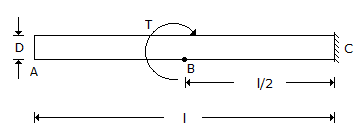Discussion
Home ‣ Civil Engineering ‣ UPSC Civil Service Exam Questions See What Others Are Saying!
- Question
A bar of circular cross-section of diameter D is subjected to a torque T at B as shown in the figure given. What is the angle of twist at A?

Options- A. Same as that at B
- B. Zero
- C. Twice as that at B
- D. Half as that at B
- Correct Answer
- Same as that at B
- 1. In plastic analysis, the shape factor for a circular section, is
Options- A. 1.5
- B. 1.6
- C. 1.7
- D. 1.75 Discuss
- 2. Meandering of a river generally occurs, in
Options- A. rocky stage
- B. delta stage
- C. boulder stage
- D. trough stage. Discuss
- 3. The plastics prepared from Vinyl resin are
Options- A. odourless
- B. non-toxic
- C. transparent
- D. colourless
- E. all of these. Discuss
- 4. Wheels of a rolling stock are provided flanges on
Options- A. outer side
- B. inner side
- C. both sides
- D. neither side. Discuss
- 5. The height of the pilot's eye above the runway surface is assumed
Options- A. 1 m
- B. 3 m
- C. 4 m
- D. 5 m Discuss
- 6. The type of steel used for precision levelling staff, is
Options- A. Titanium steel
- B. Carbon steel
- C. Invar
- D. Stainless steel. Discuss
- 7. The compaction of concrete, improves
Options- A. density
- B. strength
- C. durability
- D. all the above. Discuss
- 8. Fibre boards can be
Options- A. distempered
- B. painted
- C. painted and distempered
- D. used for furniture. Discuss
- 9. For inspection and packing of ballast, each pot sleeper is provided with
Options- A. one hole
- B. two holes
- C. three holes
- D. four holes. Discuss
- 10. The moon rotates round the earth once in every
Options- A. 29 days
- B. 29.35 days
- C. 29.53 days
- D. 30 days. Discuss
More questions
Correct Answer: 1.7
Correct Answer: trough stage.
Correct Answer: all of these.
Correct Answer: inner side
Correct Answer: 3 m
Correct Answer: Invar
Correct Answer: all the above.
Correct Answer: used for furniture.
Correct Answer: two holes
Correct Answer: 29.35 days
Comments
There are no comments.More in Civil Engineering:
Programming
Copyright ©CuriousTab. All rights reserved.
